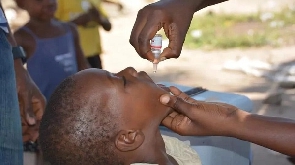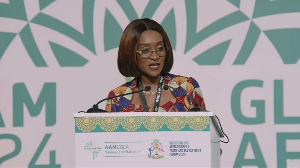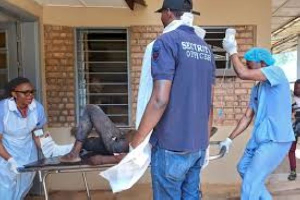In Ghana, childhood vaccination services go beyond the first year and it is the responsibility of parents, caregivers and health workers to ensure that each child receives all the needed vaccines per Ghana’s Expanded Programme on Immunization’s (EPI) schedule on time or up to five years for catch-up vaccines excluding the birth dose oral polio, rotavirus vaccine and Bacillus Calmette–Guérin (BCG), given up to a maximum two weeks, 24 weeks and age of one year respectively.
The Expanded Programme on Immunization (EPI) was established in 1974 by the World Health Organization (WHO) and the United Nations Children’s Fund (UNICEF) to combat six childhood vaccine-preventable diseases often referred to as “the six childhood killer diseases”: tuberculosis, poliomyelitis, neonatal tetanus, diphtheria, measles, and pertussis.
The goal was to achieve universal childhood immunization by 1990, with at least 80 per cent of infants fully immunized by their first birthday. EPI was introduced in Ghana, in 1978, and has been operational in all regions since 1985.
The EPI Programme aims at reducing illness and death by controlling, eliminating or eradicating vaccine-preventable diseases through vaccination. This is an essential component of the Primary Health Care concept of better health for all.
To operationalize this concept, EPI services are decentralized to the district level as a component of an integrated package of health interventions implemented by District Health Management Teams (DHMTs), institutions providing health services (public, private, and NGOs), and Sub-district Health Management Teams.
Ghana’s EPI Programme currently vaccinates against 13 vaccine-preventable diseases as part of the routine immunization system.
According to the EPI vaccine schedule, each child should receive one vaccine dose against tuberculosis at birth, three doses against diphtheria, pertussis, tetanus, hepatitis b and haemophilus influenza type ‘b’ combined pentavalent vaccine, also referred to as “Penta” (at 6, 10 and 14 weeks), four doses of oral polio vaccine (at birth, 6, 10 and 14 weeks), three doses of pneumococcal conjugate vaccine, also referred to as “PCV” (at 6, 10 and 14 weeks), two doses of rotavirus vaccine (6, 10 weeks ), one dose of inactivated polio vaccine (IPV), two doses of measles-rubella vaccine (at 9 and 18 months), one dose of yellow fever vaccine (at 9 months) and one dose of Meningitis A vaccine, also referred to as “Men A” (at 18 months).
If parents and caregivers of children closely adhere to the vaccination timelines of the EPI schedule, their babies and young children will be protected against all 13 vaccine-preventable diseases before their 2nd birthday.
Nonetheless, if any child falls behind and is unable to receive the full complement of vaccines recommended by age two, the child is still eligible for most vaccines given as “catch-up” vaccines up to age five.
A “catch-up” vaccine is defined as a vaccination received after the traditional recommended age range. Such opportunities to “catch-up” on missed doses that would normally be received on time are beneficial because they protect children who are still at risk of vaccine-preventable disease transmission, even at older ages.
Vaccination services are usually highly patronized compared to other child health interventions. However, several research findings conducted in Ghana indicate that access and utilization of vaccination services drop off after a child has reached age one.
Findings from research suggest that some parents and health workers do not consider immunization services beyond the first year as a priority or do not understand the importance of vaccines given past a child’s first year.
Two vaccines are currently provided in a child’s second year of life in Ghana – second dose measles-rubella and Men A vaccines.
These vaccines emphasize that immunization services do not end when a child reaches one year but instead continue through the second year of life and beyond.
In addition, a number of health interventions are provided during a child’s second year of life, including vitamin A supplementation, growth monitoring, and distribution of long-lasting insecticide bed nets.
These services collectively constitute the second year of life platform. An important consideration of the second year of life platform is that it acts as a safety net for children to receive appropriate catch-up vaccines.
The measles vaccine is the only vaccine given in the first year at 9-months and repeated routinely at 18-months during the second year. When the vaccine is repeated in the second year, the child is better protected from the measles disease compared to receiving only one dose of the vaccine in the first year.
Measles starts with a fever. Soon afterward, it causes a cough, runny nose, and red eyes, followed by breaking out of a rash of tiny, red spots. It spreads through the air when an infected person coughs or sneezes. It is an extremely contagious disease such that if one person is infected, nine out of 10 people around the infected person not immunized against the disease will be infected.
An unimmunized person can be infected with the measles virus by being in a room where a person with measles has been, even if the infected person left the room two hours prior. An infected person can spread measles to others even before he or she develops signs or symptoms – from four days before they develop the measles rash to four days afterward.
Meningococcal meningitis is a bacterial form of meningitis – an infection of the thin lining that surrounds the brain and spinal cord. Meningococcal bacteria are very common and live naturally in the nose and throat (upper respiratory tract).
People can carry the bacteria for days or even months without ever developing symptoms. Meningococcal meningitis is associated with high fatality or death rates (up to 50% when untreated) and high frequency (more than 10%) of severe sequelae or secondary result of the infection.
The most common symptoms of meningococcal meningitis are a stiff neck, high fever, sensitivity to light, confusion, headaches, and vomiting.
In addition to infants, bulging fontanelle and limp body are commonly found. The Men A vaccine introduced into the routine immunization system in the latter part of 2016 and given at 18-months protects a child against meningococcal meningitis.
Vaccines are safe and effective and parents or caregivers can provide the best protection for their children against vaccine-preventable diseases by following the EPI recommended immunization schedule – giving their children the vaccines they need, when they need them.
When children are not vaccinated, they are at increased risk for disease and can spread the disease to others in their play groups, child care centers, classrooms, and communities – including babies who are too young to be fully vaccinated and people with weakened immune systems.
Routine immunization services in Ghana, go beyond the “six childhood killer diseases” and past a child’s first year of life. Parents and caregivers must ensure that their children receive all the needed childhood vaccines on time and up to five years for eligible catch-up vaccines.
All stakeholders involved should communicate this invaluable information to their families, friends, communities, etc. This will contribute to reducing illnesses and deaths from a vaccine-preventable disease in our communities and Ghana as a whole.
Opinions of Sunday, 13 October 2019
Columnist: www.ghananewsagency.org



















